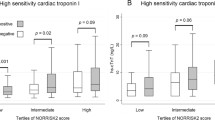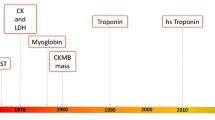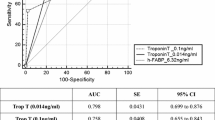Abstract
Background
We sought to determine the performance of the new high sensitivity cardiac troponin T assay (TnThs) for early diagnosis of myocardial infarction in patients with suspected acute coronary syndrome (ACS) and compare it with the fourth generation cTnT assay, myoglobin and heart-type fatty acid binding protein (h-FABP).
Methods
Ninety-four patients with diagnosis of suspected ACS without ST-segment elevation admitted to our chest pain unit were included. Patients were divided according to time from onset of symptoms to presentation into an early presenter group (<4 h) and a late presenter group (≥4 h). A median of six samples (range 2–8) were available per patient. The diagnostic performance of TnThs was assessed using ROC analysis. Areas under the curve (AUC) of baseline and follow-up results of TnThs, cTnT, myoglobin, and h-FABP were compared using c statistics.
Results
The TnThs assay allows an excellent prediction of non-ST-segment elevation myocardial infarction (non-STEMI) at presentation, particularly among late presenters. A follow-up sample improves diagnostic performance in a time-dependent manner. The AUC of TnThs was superior to cTnT at all time points. The performance of TnThs was at least as good as myoglobin and h-FABP at presentation and during follow-up.
Conclusions
A baseline sample of TnThs allows an earlier prediction of non-STEMI than the less sensitive and precise fourth generation cTnT assay. Probably, this excellent performance of TnThs at baseline and follow-up could obviate the need for other early markers of necrosis in future.




Similar content being viewed by others
References
Thygesen K, Alpert JS, White HD, On behalf of the Joint ESC/ACCF/AHA/WHF Task Force for the redefinition of Myocardial Infarction (2007) Universal definition of myocardial infarction. J Am Coll Cardiol 50:2173–2195
Hermens WT (1998) Mechanisms of protein release from injured heart muscle. Dev Cardiovasc Med 205:85–98
Morrow DA, Cannon CP, Jesse RL, Newby LK, Ravkilde J, Storrow AB et al (2007) National Academy of Clinical Biochemistry Laboratory Medicine Practice Guidelines: clinical characteristics and utilization of biochemical markers in acute coronary syndromes. Clin Chem 53:552–574
Reichlin T, Hochholzer W, Stelzig C, Laule K, Freidank H, Morgenthaler NG, Bergmann A, Potocki M, Noveanu M, Breidthardt T, Christ A, Boldanova T, Merki R, Schaub N, Bingisser R, Christ M, Mueller C (2009) Incremental value of copeptin for rapid rule out of acute myocardial infarction. J Am Coll Cardiol 54:60–68
Kleine AH, Glatz JF, Van Nieuwenhoven FA, Van der Vusse GJ (1992) Release of heart fatty acid-binding protein into plasma after acute myocardial infarction in man. Mol Cell Biochem 116:155–162
Reichlin T, Hochholzer W, Bassetti S, Steuer S, Stelzig C, Hartwiger S, Biedert S, Schaub N, Buerge C, Potocki M, Noveanu M, Breidthardt T, Twerenbold R, Winkler K, Bingisser R, Mueller C (2009) Early diagnosis of myocardial infarction with sensitive cardiac troponin assays. N Engl J Med 361:858–867
Giannitsis E, Kurz K, Hallermayer K, Jarausch J, Jaffe AS, Katus HA (2010) Analytical validation of a high sensitivity cardiac troponin T assay. Clin Chem 56:254–261
Robers M, Van der Hulst FF, Fischer MA, Roos W, Salud CE, Eisenwiener HG et al (1998) Development of a rapid microparticle-enhanced turbidimetric immunoassay for plasma fatty acid-binding protein, an early marker of acute myocardial infarction. Clin Chem 44:1564–1567
Giannitsis E, Becker M, Kurz K, Hess G, Zdunek D, Katus HA (2010) High-sensitivity cardiac troponin T for early prediction of evolving non-ST-segment elevation myocardial infarction in patients with suspected acute coronary syndrome and negative troponin results on admission. Clin Chem 56:642–650
Brogan GX Jr, Friedman S, McCuskey C, Cooling DS, Berrutti L, Thode HC Jr, Bock JL (1994) Evaluation of a new rapid quantitative immunoassay for serum myoglobin versus CK-MB for ruling out acute myocardial infarction in the emergency department. Ann Emerg Med 24:665–671
Ohman EM, Casey C, Bengtson JR, Pryor D, Tormey W, Horgan JH (1990) Early detection of acute myocardial infarction: additional diagnostic information from serum concentrations of myoglobin in patients without ST elevation. Br Heart J 63:335–338
Maisel AS, Templin K, Love M, Clopton P (2000) A prospective study of an algorithm using cardiac troponin I and myoglobin as adjuncts in the diagnosis of acute myocardial infarction and intermediate coronary syndromes in a veteran’s hospital. Clin Cardiol 23:915–920
McCord J, Nowak RM, McCullough PA, Foreback C, Borzak S, Tokarski G (2001) Ninety-minute exclusion of acute myocardial infarction by use of quantitative point-of-care testing of myoglobin and troponin I. Circulation 104:1483–1488
Ng SM, Krishnaswamy P, Morissey R, Clopton P, Fitzgerald R, Maisel AS (2001) Ninety-minute accelerated critical pathway for chest pain evaluation. Am J Cardiol 88:611–617
Apple FS, Parvin CA, Buechler KF, Christenson RH, Wu AH, Jaffe AS (2005) Validation of the 99th percentile cutoff independent of assay imprecision (CV) for cardiac troponin monitoring for ruling out myocardial infarction. Clin Chem 51:2198–2200
Eggers KM, Oldgren J, Nordenskjöld A, Lindahl B (2004) Diagnostic value of serial measurement of cardiac markers in patients with chest pain: limited value of adding myoglobin to troponin I for exclusion of myocardial infarction. Am Heart J 148:574–581
Apple FS, Smith SW, Pearce LA, Ler R, Murakami MM (2008) Use of the Centaur TnI-Ultra assay for detection of myocardial infarction and adverse events in patients presenting with symptoms suggestive of acute coronary syndrome. Clin Chem 54:723–728
Gaze DC (2010) High-sensitive cardiac troponin assays: application for prime-time use. Biomark Med 4:341–343
Lippi G, Montagnana M, Guidi GC (2009) The clinical dilemma of positive results of high-sensitive troponin assays. Am J Cardiol 103:1332
Neizel M, Steen H, Korosoglou G, Lossnitzer D, Lehrke S, Ivandic BT, Katus HA, Giannitsis E (2009) Minor troponin T elevation in patients 6 months after myocardial infarction: an observational study. Clin Res Cardiol 98:297–304
Wu AHB, Lu QA, Todd J, Moecks J, Wians F (2009) Short- and long-term biological variation in cardiac troponin I measured with a high-sensitivity assay: implications for clinical practice. Clin Chem 55:52–58
Seino Y, Tomita Y, Takano T, Ohbayashi K, Tokyo Rapid-Test Office Cardiologists (Tokyo-ROC) Study (2004) Office cardiologists cooperative study on whole blood rapid panel tests in patients with suspicious acute myocardial infarction: comparison between heart-type fatty acid-binding protein and troponin T tests. Circ J 68:144–148
Valle HA, Riesgo LG, Bel MS, Gonzalo FE, Sanchez MS, Oliva LI (2008) Clinical assessment of heart-type fatty acid binding protein in early diagnosis of acute coronary syndrome. Eur J Emerg Med 15:140–144
Ghani F, Wu AH, Graff L, Petry C, Armstrong G, Prigent F, Brown M (2000) Role of heart-type fatty acid-binding protein in early detection of acute myocardial infarction. Clin Chem 46:718–719
Keller T, Zeller T, Peetz D, Tzikas S, Roth A, Czyz E, Bickel C, Baldus S, Warnholtz A, Fröhlich M, Sinning CR, Eleftheriadis MS, Wild PS, Schnabel RB, Lubos E, Jachmann N, Genth-Zotz S, Post F, Nicaud V, Tiret L, Lackner KJ, Münzel TF, Blankenberg S (2009) Sensitive troponin I assay in early diagnosis of acute myocardial infarction. N Engl J Med 361:868–877
Ilva T, Lund J, Porela P, Mustonen H, Voipio-Pulkki LM, Eriksson S, Pettersson K, Tanner P, Pulkki K (2009) Early markers of myocardial injury: cTnI is enough. Clin Chim Acta 400:82–85
Acknowledgments
The investigations were supported by Roche Diagnostics, Germany providing assays for TnThs. EG has received research grants for clinical trials from Roche Diagnostics & MSD Germany. He is consultant to Roche Diagnostics and has received speakers honoraria from Roche Diagnostics and Mitsubishi Chemicals. HAK has developed the cTnT assay and holds a patent jointly with Roche Diagnostics. He has received grants and research support from several companies, and has received honoraria for lectures from Roche Diagnostics. Dr. D. Zdunek and Prof. G. Hess are employees of Roche Diagnostics responsible for the preclinical testing of TnThs.
Author information
Authors and Affiliations
Corresponding author
Rights and permissions
About this article
Cite this article
Kurz, K., Giannitsis, E., Becker, M. et al. Comparison of the new high sensitive cardiac troponin T with myoglobin, h-FABP and cTnT for early identification of myocardial necrosis in the acute coronary syndrome. Clin Res Cardiol 100, 209–215 (2011). https://doi.org/10.1007/s00392-010-0230-y
Received:
Accepted:
Published:
Issue Date:
DOI: https://doi.org/10.1007/s00392-010-0230-y




